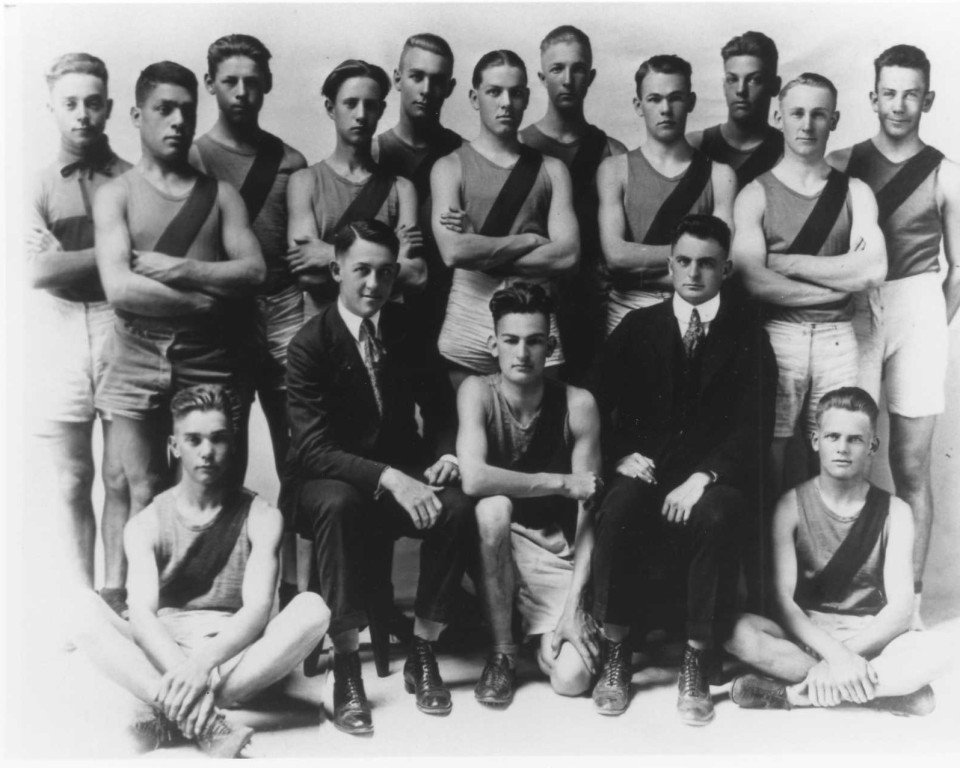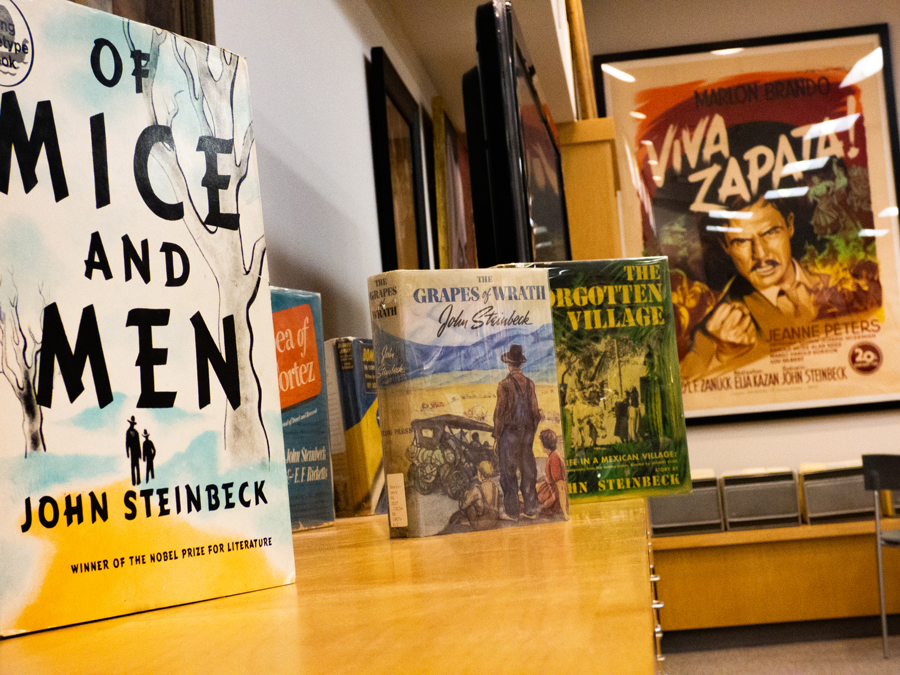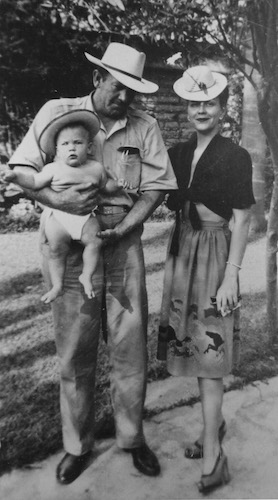Chronology
A Brief Chronology of Events in John Steinbeck's Life
by Robert B. Harmon
1900–1929 | 1930–1940 | 1941–1948 | 1950–1968 | Some Subsequent Events of Interest: 1969–1989 | 1991–Present
1900–1929
27 February 1902: Steinbeck born in Salinas, California, the third of four children and the only son of John Ernst II and Olive Hamilton Steinbeck. He spent his childhood and adolescence in the Salinas Valley, later called the "Salad Bowl of the Nation."

Yearbook photo of the Salinas High School track team. John Steinbeck is on the far right in the back row.
1915-19: Attended Salinas High School (Original building no longer in existence.)
1919-25: Attended classes at Stanford University, leaving without taking a degree. During these years, Steinbeck dropped out for several months and was employed intermittently as a sales clerk, farm laborer, ranch hand, bench chemist and factory worker.
November 1925: traveled by freighter from Los Angeles to New York City; worked as a construction laborer and, briefly, for the New York American
1926-28: lived in Lake Tahoe, California and worked as a caretaker for a summer home.
August 1929: publication of first novel, Cup of Gold, by McBride (New York).
1930–1940
14 January 1930: marries Carol Henning. October, meets Edward F. Ricketts, marine biologist, philosopher, longtime friend.
October 1932: novel, The Pastures of Heaven, published by Brewer, Warren, and Putnam (New York).
September 1933: novel, To A God Unknown published by Ballou (New York).
1934: Gathers information on farm labor unions. Interviews labor organizer in Seaside.
28 May 1935: first popular success, novel Tortilla Flat about Monterey's paisanos. Published by Covici-Friede (New York); beginning of lifelong friendship with editor Pascal Covici.
October 1936: novel, In Dubious Battle, about striking workers. Published by Covici-Friede.
06 February 1937: play-novelette, Of Mice and Men published by Covici-Friede; Summer, first trip to Europe and Russia; September, The Red Pony, three connected stories, published by Covici-Friede; November 23, New York opening of the play Of Mice and Men (207 performances).
April 1938: Their Blood Is Strong, a nonfiction account of the migrant labor problem in California, published by the Simon J. Lubin Society (San Francisco); May, receives the New York Drama Critics Circle Award for the play Of Mice and Men; September, short story collection, The Long Valley, incorporating The Red Pony (1937), published by Viking (New York), where Pascal Covici became an editor after the bankruptcy of his own firm.
 April 1939: The Grapes of Wrath, his greatest critical success, published by Viking, provoking both great popular
acclaim and violent political condemnation for its depiction of Oklahoma migrants
and California growers, as well as for its alleged "vulgar" language and socialist
bias. December, film of Of Mice and Men released.
April 1939: The Grapes of Wrath, his greatest critical success, published by Viking, provoking both great popular
acclaim and violent political condemnation for its depiction of Oklahoma migrants
and California growers, as well as for its alleged "vulgar" language and socialist
bias. December, film of Of Mice and Men released.
January 1940: film of The Grapes of Wrath released; March 11 - April 20, marine expedition in the Gulf of California with Ricketts;
Spring, receives the National Book Award and the Pulitzer Prize for The Grapes of Wrath; Summer, documentary film about living conditions in rural Mexico, The Forgotten Village.
1941–1948
Spring 1941: separated from Carol; Fall, moves to New York City with singer Gwyndolyn Conger; 05 December, Sea of Cortez, written with Edward Ricketts, published by Viking.
March 1942: sued for divorce by Carol; 06 March, novel, The Moon Is Down published by Viking; 08 April, New York opening of the play The Moon Is Down; May, film of Tortilla Flat released; 27 November, Bombs Away published by Viking.
March 1943: film of The Moon Is Down released; 29 March, marries Gwyn Conger in New Orleans; June-October, in Europe and North Africa as war correspondent for New York Herald Tribune. Divorce from Carol final.
 02 August 1944: birth of first son, Thom.
02 August 1944: birth of first son, Thom.
02 January 1945: publication of novel Cannery Row, by Viking.
12 June 1946: birth of second son, John IV.
February 1947: novel, The Wayward Bus, published by Viking; August-September, tour of Russia with photographer Robert Capa, for the New York Herald Tribune; November, novella The Pearl published by Viking.
April 1948: A Russian Journal, an account of his 1947 tour of Russia, published by Viking; May, Ed Ricketts killed
in automobile accident; August, divorced by Gwyn; December, elected to American Academy
of Arts and Letters.
1950–1968
October 1950: novella, Burning Bright, published by Viking.
18 October 1950: New York City opening of the play Burning Bright.
28 December 1950: marries third wife, Elaine Anderson Scott.
September 1951: The Log from the Sea of Cortez, the narrative part of the Sea of Cortez (1941) including an original essay "About Ed Ricketts," published by Viking.
March 1952: film, Viva Zapata! released (screenplay published in Rome by Edizoni Filmcritica in 1953; first published in America, edited by Robert Morsberger, by Viking in 1975); September, novel East of Eden published by Viking.
June 1954: novel, Sweet Thursday, published by Viking (a sequel to Cannery Row).
March 1955: purchases a summer home in Sag Harbor, Long Island, New York; 03 November, New York City opening ofPipe Dream, a Richard Rogers and Oscar Hammerstein III musical based on Sweet Thursday.
April 1957: novel, The Short Reign of Pippin IV, published by Viking; film of The Wayward Bus released.
September 1958: Once There Was a War, a collection of his 1943 wartime dispatches, published by Viking.
February - October 1959: travels in England and Wales, researching background for a modern English version of Malory'sMorte Darthur (1485).
September - November 1960: tours United States with poodle, Charley.
April 1961: twelfth novel, The Winter of Our Discontent, published by Viking.
July 1962: Travels with Charley, the journal of his 1960 tour, published by Viking; 25 October, Steinbeck is awarded the Nobel Prize for Literature.
October - December 1963: travels to Scandinavia, Eastern Europe, and the Soviet Union on United States Information Agency cultural tour with dramatist Edward Albee.
14 September 1964: presented with United States Medal of Freedom by President Lyndon B. Johnson.
12 October 1966: America and Americans, reflections on contemporary America, published by Viking.
December 1966 - January 1967: extensive visit to South Vietnam for fact-finding and to visit John IV.
20 December 1968: dies of arteriosclerosis in New York City.
Some Subsequent Events of Interest
1969–1989
1969: Publication of Journal of a Novel: The East of Eden Letters, journal kept during composition of East of Edenpublished by Viking.
1975: Steinbeck: A Life in Letters (selected correspondence), edited by Elaine Steinbeck and Robert Wallsten, published by Viking.
1976: Publication of The Acts of King Arthur and His Noble Knights (edited by Chase Horton), an unfinished translation ofMorte d'Arthur
1979: U.S. commemorative stamp issued on what would have been his seventy-seventh birthday
1984: The True Adventures of John Steinbeck, Writer (biography), by Jackson J. Benson is published by Viking; pictured on 0.5 troy ounce (15.55 gram) gold medal issued by the U.S. Government.
1987: First issue of The Steinbeck Newsletter, later Steinbeck Studies, the Steinbeck journal published by San Jose State University
1989: Working Days: The Journal of The Grapes of Wrath,edited by Robert DeMott (journal Steinbeck kept during writing of the novel in 1938, published on the novel's fiftieth anniversary).
"The Grapes of Wrath, 1939-1989: An Interdisciplinary Forum" held at San José State
University.
1991–Present
1991: Frank Galati's Steppenwolf Theater dramatization of The Grapes of Wrath wins New York Drama Critics' Circle Award for best play of the season. Donald V. Coers' John Steinbeck as Propagandist published by University of Alabama Press.
1992: Gary Sinise and John Malkovich direct and star in another film version of Of Mice and Men; Nantucket conference on "Steinbeck and the Environment," co-sponsored by the Steinbeck Research Center and University of Massachusetts.
1994: Biography by Jay Parini, John Steinbeck: A Biography is published in England by Heinemann.
1995: A revised version of Parini's biography (Henry Holt) and Parallel Expeditions: Charles Darwin and the Art of John Steinbeck by Brian E. Railsback (University of Idaho Press) are published.
1997: "Beyond Boundaries: Steinbeck and the World," the Fourth International Steinbeck Congress, held in San Jose and Monterey in March. Co-sponsored by the Center for Steinbeck Studies and the Japanese Steinbeck Society.
March 2002: Steinbeck Centennial. " John Steinbeck's Americas" conference held at Hofstra University.
2004: Steinbeck Review begins publication. The Review and Steinbeck Studies later merged and became part of Wiley-Blackwell's American Literature Collection.
2007: On-line bibliography of secondary sources, with over 7,000 articles, goes live.
2008: The first of a four volume series, John Steinbeck, World War II Correspondent: An Annotated Reference Guidepublished by R. B. Harmon (DibCo).
2009: A John Steinbeck Reader: Essays in Honor of Stephen K. George, edited by Barbara A. Heavilin, published by Scarecrow Press.
2012: Steinbeck in Vietnam: Dispatches from the War, edited by Thomas E. Barden, published by University of Virginia Press.
About Robert B. Harmon
R. B. Harmon (DibCo) publishes three volumes of translated and documented guides to Steinbeck's journalistic writings, including:
John Steinbeck and Newsday with a Focus on 'Letters to Alicia': An Annotated and Documented Reference Guide.
John Steinbeck and the Saturday Review: An Annotated and Documented Guide to Information Sources.
John Steinbeck and the Louisville Courier-Journal: An Annotated and Documented Guide to Information Sources.